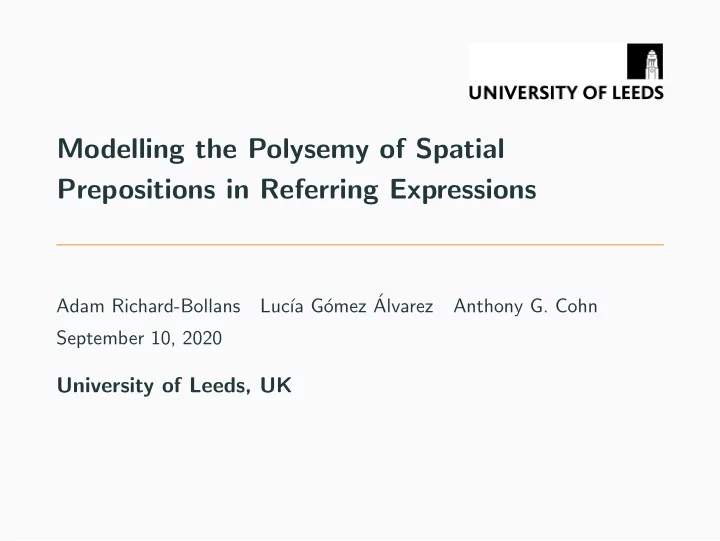

Modelling the Polysemy of Spatial Prepositions in Referring Expressions omez ´ Adam Richard-Bollans Luc´ ıa G´ Alvarez Anthony G. Cohn September 10, 2020 University of Leeds, UK
Introduction • Modelling spatial prepositions (‘in’, ‘inside’, ‘on’, ‘on top of’, ‘against’, ‘above’, ‘over’, ‘below’ & ‘under’) in situated dialogue - in particular in referring expressions • (Some) Spatial prepositions exhibit polysemy • How should can the semantics of polysemous terms be managed in grounded settings? 1
Which Prepositions? In this paper we consider those spatial prepositions which appear to both have an ‘ideal meaning’ and to exhibit polysemy at the kind of room-scales we are considering: • ‘in’ [Rodrigues et al., 2020] • ‘on’ [Bowerman and Choi, 2001] • ‘under’ [Zlatev, 1992] • ‘over’ [Tyler and Evans, 2001; Zlatev, 1992] 2
Spatial Language & Polysemy Figure 1: Examples from [Bowerman and Choi, 2001] of the variability of ‘on’ 3
Data Collection & Environment Framework • Virtual environments built in Unity3D, from which Figure 2: Preposition Selection geometric and functional Task features are extracted • Provides a task for generating models and a task for testing models 4 Figure 3: Comparative Task
Data Collection & Environment Existing Model • In [Richard-Bollans et al., 2020] we create a cognitive model based on Prototype Theory which, trained on Figure 4: Preposition Selection Task instances from the Preposition Selection Task, performs well in the Comparative Task . • How can we incorporate polysemy? 5 Figure 5: Comparative Task
Identifying Polysemes What are the distinct polysemes that may be expressed by a preposition, and how can they be differentiated? Figure 6: Examples of ‘on’ 6
Basic Notions & Ideal Meanings [Herskovits, 1987] argues that the meanings of spatial prepositions are centred around ‘ ideal meanings ’, from which other uses of the prepositions are derived. For example, the ideal meaning of the preposition ‘in’ is inclusion of a geometric construct within another geometric construct . This is roughly captured by the containment image schema in Figure 7. Figure 7: Image-schema for containment [Mandler, 1992] 7
Representing Ideal Meanings Following various accounts of spatial prepositions, we suppose that the underlying semantics of these terms may comprise both geometric and functional components. For example, we represent the ideal meaning of ‘on’ by a high degree of support , contact and above proportion 1 . Each preposition is associated with a set of conditions which represent its ideal meaning. 1 A feature indicating the degree to which the figure is above the ground. 8
Non-Ideal Senses The variety of usages displayed by spatial prepositions are realised via adaptations of the ideal meaning [Herskovits, 1987]. The ‘ Principled Polysemy ’ approach of [Tyler and Evans, 2001], relying on a similar notion to the ‘ideal meaning’, aims to provide criteria for when senses are genuinely distinct. Simplifying this approach, we get: Criterion : A sense may be considered distinct if the sense meaningfully differs from other senses with regards to some spatial or functional features What do we mean by ‘meaningfully differs’? 9
Non-Ideal Senses Criterion : A sense may be considered distinct if the sense meaningfully differs from other senses with regards to some spatial or functional features We suppose that whether a sense satisfies or violates one of the conditions of the ideal meaning constitutes a meaningful distinction. Figure 8: Examples of ‘on’ 10
Determining Typicality We now have a set of polysemes for each preposition, and can train our model to assign a typicality score to configurations with respect to a given polyseme. How do we exploit this in processing referring expressions? Figure 9: Confusion of ‘the object on the table’ 11
Polyseme Hierarchy It is apparent that there is a hierarchy of senses. We assign a rank to each sense, generated by collected data, which accounts for this hierarchy. For a given preposition, overall typicality of a configuration, c , is calculated as follows: typicality ( c ) = p ∈ Polysemes ( typicality p ( c ) × rank p ) max (1) 12
Model Performance Polysemy Baseline k -Means Model Model Model 0.801 0.790 in 0.813 0.94 0.924 on 0.952 0.764 0.882 under 0.898 0.800 0.685 over 0.814 0.825 0.827 Average 0.863 0.845 0.869 Overall 0.893 Table 1: K-Fold Test Results (K=10, N=10). Scores are averaged results of the cross-validation 13
Summary • Provided a method of distinguishing meaningful clusters within categorical data on spatial prepositions, based on ‘ideal meanings’ and the ‘principled polysemy’ approach • Introduced a notion of ‘polyseme hierarchy’ to aid typicality judgements 14
References i Bowerman, M., & Choi, S. (2001). Shaping meanings for language: Universal and language-specific in the acquisition of semantic categories. In Language acquisition and conceptual development . Cambridge University Press. Herskovits, A. (1987). Language and spatial cognition . Cambridge University Press. Mandler, J. M. (1992). How to build a baby: II. Conceptual primitives.. Psychological review , 99 (4), 587. Richard-Bollans, A., Bennett, B., & Cohn, A. G. (2020). Automatic generation of typicality measures for spatial language in grounded settings. In Proceedings of 24th European Conference on Artificial Intelligence . 15
References ii Rodrigues, E. J., Santos, P. E., Lopes, M., Bennett, B., & Oppenheimer, P. E. (2020). Standpoint semantics for polysemy in spatial prepositions. Journal of Logic and Computation . https://doi.org/10.1093/logcom/exz034 Tyler, A., & Evans, V. (2001). Reconsidering prepositional polysemy networks: The case of over. Language , 77 (4), 724–765. Zlatev, J. (1992). A study of perceptually grounded polysemy in a spatial microdomain (Technical Report TR-92-048). International Computer Science Insitute. Berkley, California. 16
Recommend
More recommend